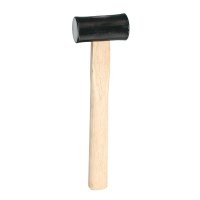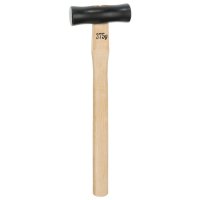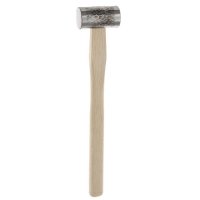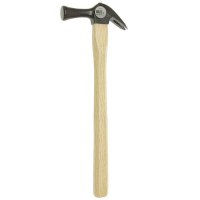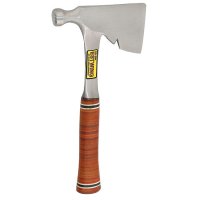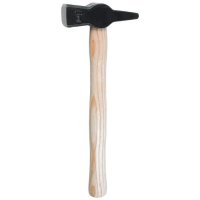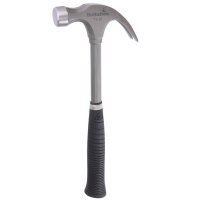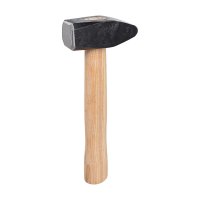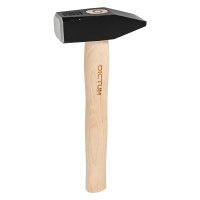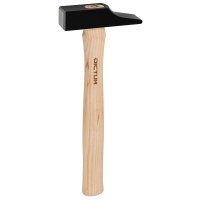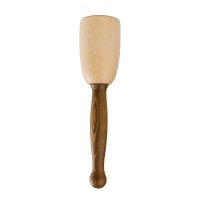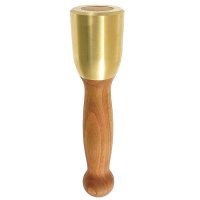Content
Two million years ago, the history of mankind, and that of the hammer, began when one of our ancestors first picked up a stone to use it as a striking tool. Another soon realized that the power of the tool could be greatly increased by attaching a handle made of wood, bone or horn. The continual inventiveness of the human mind and the advent of metalurgy have allowed countless variations to be made in the hammer's design to better aid us in hunting, construction of dwellings, etc. To this day, the hammer has remained essential to all humankind, but especially to the woodworker.
Japanese Hammers (Tsuchi)

The simple outward appearance of the Japanese hammer conceals its inner sophistication.
The hammer head is soft in the middle and hardened only at the ends. This allows the full force of a blow to be transferred while simultaneously dampening vibrations and reducing the hammer's 'bounce'. One face of the hammer is flat while the other is ground with a slight crown, making it especially useful for driving wooden nails flush with a surface and for marquetry work.
The Genno's high efficiency means you can generally select a lighter weight in comparison to conventional European hammers. The handles are made of sturdy, wear-resistant Japanese white oak (Boshu). They are extra long and ergonomically designed for comfortable use. Replacement handles are available upon request. The specified weights refer to the weight of the head alone.
Japanese Hammers - Types
-
4-Kaku Genno

Octagonal-headed hammer with flat cheeks which can be used as additional striking surfaces. Ideal for adjusting tools and fitting, i.e. setting plane irons, leveling and inlaying. White oak handle, unvarnished. -
8-Kaku Genno

Traditional, square-headed hammer with rounded edges. The profile of the head is tapered towards the middle to increase directional stability during use. General-purpose hammer for assembly work, driving nails, etc. A 375 g Genno us usually used for striking Japanese chisels (Nomi). White oak handle, unvarnished.
Estwing and Picard
-
ESTWING Tools

The heads, necks and handles of these hammers are joined seamlessly to make these indestructible striking tools. The heads and full-length tangs are forged from one piece of tool steel, differentially hardened and polished over its entire surface. Ergonomically designed leather handle. -
PICARD Latthammer 698

The quality standards for German hammers have been set by the PICARD company since it was founded in 1857. The model 698 is a tool which should be in every woodworker's tool-box. Unbreakable, steel tube handle with a vibration dampening, non-slip elastomer grip. Head with differentially hardened point and claw, checkered face and magnetic nail slots which can also accommodate small nails.
Leather Hammer & Wooden Mallet
-
Leather Hammer

This thick-skinned hammer is not easily fazed by large tasks. The leather heads of are made of coiled American buffalo hide which dampens the blow and protects the surfaces of sensitive pieces from damage. Ideal for furniture assembly, interior, restoration, parquetry and tiling work. The heads are highly resistant to wear and can also be used for striking chisels and carving tools. Ergonomic hickory handles.
TOVE Wrecking Bars

Tove wrecking bars are as indispensable to a Swedish fireman as they are to a carpenter working on a construction site. These fine tools have been synonymous with quality and reliability for over 50 years. The steel is fully hardened and therefore particularly light, a feature which will certainly not go unnoticed when working in the field. The wide, precision ground pry tips at both ends allow the bar to be easily wedged without damaging the surface of the piece.
Nail Starter (Marutsuba Nomi)

Carpenter's tool for making pilot holes for long nails. Forged, hardened steel with hilt to facilitate removal from the wood. Red oak handle.
Hammering Tips

When driving a nail into a piece of wood, friction causes an incredible amount of heat to be produced. This heat destroys the wood's fibers and tends to loosen the nail's ultimate grip on the wood. It is therefore best to use the shortest, thinest aprropriate nail and to tap it in up to the neck using soft blows and then seat it with one sharp tap.
The flat face of the Genno should be used to tap the nail and the curved face to seat it.
Where does the name Genno come from?
An old Japanese legend tells a story about the Genno, which we would like to tell you.
In the year 1385 AD, several people died mysteriously in the Tochigi prefecture. A stone named Sesshouseki, which was presumably possessed by an evil spirit, was responsible for these events. This stone killed all living beings around it – birds fell to the ground, and people around it suddenly died for no apparent reason.
In order to stop this horror, a monk named Gennou Shinsho set off to the valley where the stone was. With a hammer, which was later on called "Genno" and resembled the shape it still has today, he attacked the stone. With only one heavy stroke, the stone was destroyed and the pieces were shot to the provinces Okyayama, Niigata, Hiroshima, Oita, and Gunma. Since this legend exists, the Genno has got its name.
"The valley where the stone was located is an area of volcanic origin, and stones in this area still contain volcanic gases which are made up of hydrogen sulphide, sulphur dioxide and arsenic."






